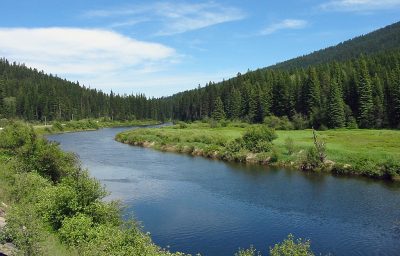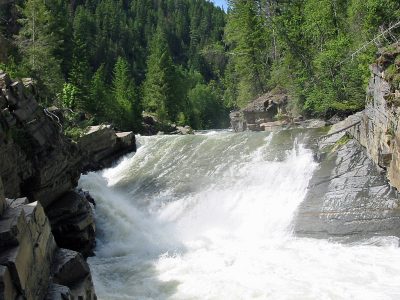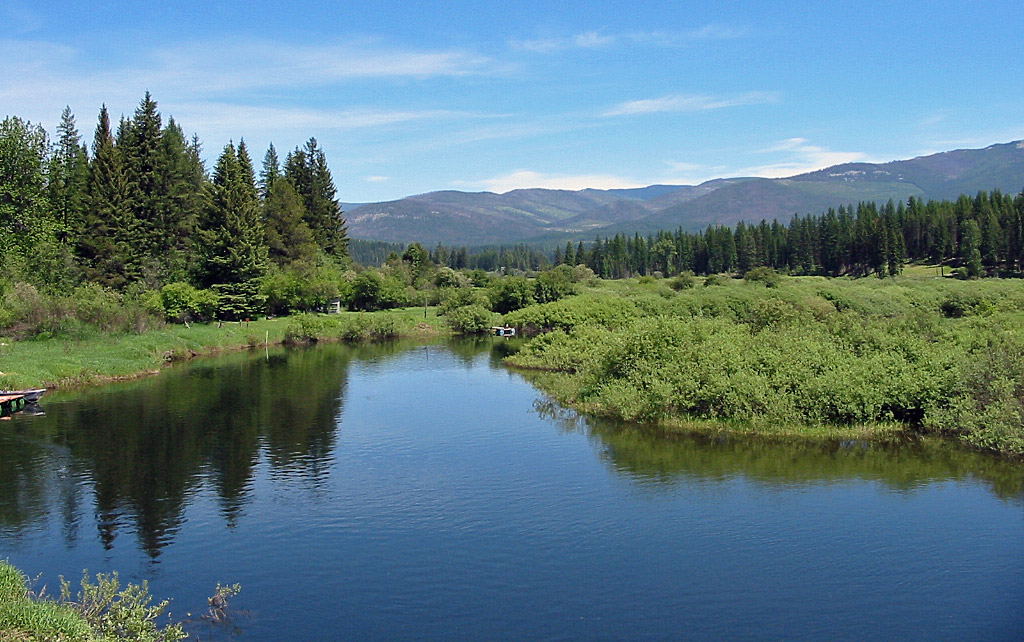The Yaak River begins in British Columbia, as the North Fork Yaak, flowing for 25 miles before entering Montana. Three miles across the border, the East Fork Yaak joins the North Fork, giving rise to the Yaak River. The West Fork Yaak joins the Yaak River four miles further downstream. The river then flows through heavily wooded, mountainous terrain until its confluence with the Kootenai River.
Article Contents:
Related Article – Photographs of the Yaak River
Yaak River | Overview
The Yaak River flows through sparsely inhabited country, passing through only one town on it’s way to the Kootenai, a tiny town called Yaak Village. The valley the Yaak River travels through, known as the Yaak Valley, is quite scenic and very remote.
Use of the Yaak River is generally quite low. Most of the fishing and floating pressure on the Yaak River comes from the local population, as few out-state fisherman make their way up to this remote and isolated section of Montana on a fly fishing trip.
The Yaak region of Montana is known for its extensive wildlife, including grizzly bears, black bears and a healthy population of moose. The river itself offers good trout fishing both above and below Yaak Falls. And in the rivers lower stretches, the Yaak offers the daring floater some wonderful rafting or kayaking opportunities.
Fishing the Yaak River
The Yaak River is a fine river to fly fish. The Yaak offers up average sized rainbows, cutthroats and a healthy population of larger brook trout.
The Yaak River region is very isolated. Not surprisingly, fly fishing pressure on the Yaak is quite low, with the bulk of all fishermen being locals. Thus, the Yaak River can provide a visiting angler with a fine opportunity to fish in an un-crowded river in a remote, quiet setting.
Yaak River : Origin to Yaak Village
In the upper portion of the river, the current varies from slow to moderate. The riverbanks are a nice mix of trees, bushes and grass. The upper portion, above Yaak Village, is where the rivers biggest surprise is found—large brook trout, perhaps the largest found in Montana.
Catching these brookies can be an exercise in both frustration and patience. Like brook trout in other rivers, the small ones are not difficult to catch. They will rise readily to a dry fly and, later in the summer, hoppers and ants.
Where the challenge lies in fly fishing for these brookies is catching the large ones that go over three pounds—a size not entirely unusual in the Yaak. To catch the larger brook trout, streamers are the anglers’ best bet. Fish the streamers in the deep pools, as this is where the larger fish will be found. Be fully prepared to lose many flies, as the bottom of the Yaak River contains countless trees and downfall. Additionally, during late summer, hoppers can also draw the larger trout out of the pools and up to the surface.
Yaak River – Yaak Village to Kootenai River
Further downstream, below Yaak village, the lower half of the river offers good fly fishing for rainbow trout. The lower half of the river is split into two sections by Yaak Falls, which lies 9 miles above the confluence with the Kootenai River.

The Yaak River in Northwest Montana. Above Yaak Falls, the river has good access and is easy to float.
Above the falls and extending up to Yaak Village, extensive pools and riffles are found, allowing for classic dry fly fishing. At Yaak Village, the river is quite small, but picks up width and volume as it travels further downstream towards Yaak Falls. Except for in the vicinity of Yaak Village, access to this section of the river is excellent. Throughout this section, the river flows through a mix of private and public land, with a paved road closely following the river. The flow of the Yaak River in this section is generally slow to moderate, although a section of almost dead water does exist below the Whitetail campground.
This section of the Yaak River provides easy fly fishing for wade fisherman. Due to the rivers frequent narrow width, its twisty nature, sometimes very slow flows and easy access, this section of the Yaak River is an excellent place for wade fishing. Fishing pressure is generally low and the rainbows are not exceptionally picky. Standard dry flies, especially in the morning and evening hours, when matched to the local hatch will work well. Hopper imitations also work very well beginning in July and lasting through early-September. Average sized rainbows in this stretch will run between 10-14 inches, with 16-inch rainbows not uncommon.
When fly fishing this section of the Yaak River, anglers may also encounter two endangered fish, the bull trout and the native inland redband rainbow trout. Both fish species are illegal to take, so if you catch one, take the normal precautions to release the fish with as little stress and injury as possible.
Below Yaak Falls, especially right near the falls, is where the larger rainbow trout can be found. Unfortunately, to get at them is not an easy feat. Below Yaak Falls the Yaak River flows into a canyon that extends down to the confluence with the Kootenai River, making for either a long upstream hike from Highway 2 or a steep climb down into the canyon from upriver. Fishing in this section by boat is out, as the river below Yaak Falls has extensive whitewater sections all the way to the Kootenai River and because there is no easy way to get a boat down to the Yaak below the falls. Either way, access to this canyon stretch is difficult.
Overall, the Yaak River may not hold the lunker trout that other Montana rivers do. However, the remote and scenic setting, quality trout fishing and low fishing pressure make the Yaak River a worthy destination for anyone visiting Montana on a fly fishing trip.
Floating & Rafting the Yaak River
The Yaak River offers a number of possibilities for both the beginner and advanced floater. Above Seventeen Mile Bridge (located 4 miles above Yaak Falls) and extending up to the confluence of the East and North Fork of the Yaak, the river has a mix of gentle to moderate flows, although there is one section of almost dead water that could prove annoying to rafters. The rivers width varies from quite narrow above Yaak Village to medium width below. Occasional logjams that are avoidable except in very low water will also be encountered.

Yaak Falls on the Yaak River. Unless you are a confident paddler in Class V whitewater, going over Yaak Falls isn’t suggested.
Due to the rivers narrow width and its propensity for twist and turns, large rafts are not recommended above Yaak Village. Canoes, inflatable canoes, inflatable kayaks, smaller inflatable rafts and drift-boats are the best vessels for this stretch.
Below Yaak Village, the Yaak River gradually picks up width, and becomes suitable for large rafts beginning near the Pete Creek Campground.
Below Seventeen Mile Bridge, the character of the Yaak River changes considerably. For the four miles leading up to Yaak Falls, the river current picks up velocity, with numerous boulders and some Class II-III rapids.
And then there is Yaak Falls, which must be portaged. There is no easy portage of Yaak Falls. About the only way to do a portage around Yaak Falls is to road walk from Yaak Falls down to the campground, and then muscle the boat down a very steep, wooded embankment.
Below Yaak Falls, the Yaak River flows through a canyon that has extensive whitewater. Numerous Class II- III rapids exist, along with two Class IV-V drops, depending on river flows. As the river moves quickly and is hemmed in by the canyon, portaging and even scouting is difficult. This section is for advanced rafters and kayakers only.
Yaak River : River Miles
- North Fork at Canadian Border: 53
- East Fork Yaak Confluence: 49
- West Fork Yaak Confluence: 45
- Upper Ford Bridge: 43
- Yaak Bridge (Yaak Village): 34
- Pete Creek: 31
- Whitetail: 28
- Seventeen Mile Bridge: 13
- Yaak Falls: 9.2
- Campground: 9
- Confluence with Kootenai River: 0
Related Articles on Big Sky Fishing.Com
Other Web Resources


